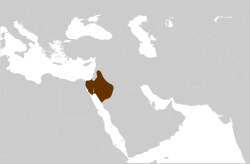
Back مملكة الأنباط Arabic مملكة الانباط ARZ Nəbatilər dövləti Azerbaijani Набатея Bulgarian Nabatejské království Czech Reino nabateo Spanish Nabatea Basque پادشاهی نبطی Persian Royaume nabatéen French הממלכה הנבטית HE
Nabataean Kingdom 𐢕𐢃𐢋𐢈 | |||||||||||||
|---|---|---|---|---|---|---|---|---|---|---|---|---|---|
| 3rd century BC–106 AD | |||||||||||||
 The Nabataean Kingdom at its greatest extent | |||||||||||||
| Capital | Petra 30°19′43″N 35°26′31″E / 30.3286°N 35.4419°E | ||||||||||||
| Common languages |
| ||||||||||||
| Religion | Nabataean religion | ||||||||||||
| Demonym(s) | Nabataean | ||||||||||||
| Government | Monarchy | ||||||||||||
| King | |||||||||||||
| Historical era | Antiquity | ||||||||||||
• Established | 3rd century BC | ||||||||||||
| 90 BC | |||||||||||||
• Conquered by the Roman Empire | 106 AD | ||||||||||||
| Currency | Nabataean Denarius | ||||||||||||
| |||||||||||||
| Historical Arab states and dynasties |
|---|
 |
The Nabataean Kingdom (Nabataean Aramaic: 𐢕𐢃𐢋𐢈 Nabāṭū), also named Nabatea (/ˌnæbəˈtiːə/) was a political state of the Nabataeans during classical antiquity. The Nabataean Kingdom controlled many of the trade routes of the region, amassing large wealth and drawing the envy of its neighbors. It stretched south along the Tihamah into the Hejaz, up as far north as Damascus, which it controlled for a short period (85–71 BC). Nabataea remained an independent political entity from the mid-3rd century BC until it was annexed in AD 106 by the Roman Empire, which renamed it to Arabia Petraea.